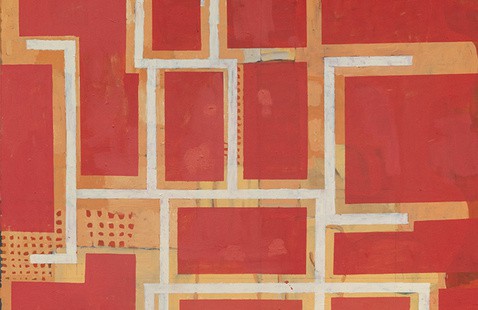The Sarah Moody Gallery of Art is currently the home to “March,” an exhibit featuring the art of Sharon Butler, New York City-based artist and creator of the Two Coats of Paint blog. Students and local residents can view 18 of Butler’s original pieces that showcase a new and growing trend in the art world: casualism.
Butler’s art, characterized by its depiction of static geometric shapes overlaying a grid pattern, spans back as far as 2017, although the ones featured in Sarah Moody are from 2019 onward. Her paintings began as “Good Morning Drawings,” using an app called Picsart. The inspiration for the geometric shapes came from her self-imposed limitation to use only the available square, circle, triangle and rhombus tools the app had to offer.
Vicki Rial, the exhibition coordinator for the Sarah Moody Gallery, said that Butler’s art showed “a strong connection to technology, but uses the humanity of colors.”
The grid-based pattern sketched underneath Butler’s paintings, a conventional art technique, gives the appearance of pixelated art. Butler does not use precision, however, to sculpt her basic shapes, another element that adds a degree of humanness to the art that was originally drawn on a phone, Rial said.
When looking closely at Butler’s work, a viewer can see not only the grid sketch that she built her work upon, but also the underlying color in some of the squares because they are not filled in.
Small corners reveal what the audience might believe is a mistake but is in fact very intentional. Butler is part of a growing art trend called casualism. In a 2011 article on Two Coats of Paint, Butler wrote that this “provisional painting” arose after artist Raphael Rubinstein dubbed it a “new type of abstraction” in the same year. Casualism is defined by purposeful imperfection.
“The idea is to cast aside the neat but rigid fundamentals learned in art school and embrace everything that seems to lend itself to visual intrigue — including failure,” Butler wrote.
Rial credited Butler with popularizing the 21st century style of abstract art and admired her artistry, “because of the way you can see she applied the paint, because you can see what she applied underneath, it gives it a very human touch.”
Rial referred to the many small spots viewers can see of the different layers and coats of paint that Butler did not attempt to hide.
On March 20, Butler gave a lecture about the origin and craft of her artwork at the Yellowhammer Room in Gorgas Library.
The title of her exhibition, “March,” was chosen by her and associate art professor William “Bill” Dooley. Its dual meaning, as a noun denoting a certain period of time and a verb signifying motion, reflects the primary theme of her showcase. Butler is determined to continue moving forward and grow with her art.
“It’s the kind of bossy command that comes when I’m having trouble moving forward on a project,” Butler said.
She said that while many artists have renounced casualism as an art form for its “implied lack of rigor,” she finds it freeing.
“I saw casualist work as reflecting a joyful, what-the-hell, anti-Bauhaus approach, rather than a Beckett-like response to the dire conviction that painting was dead,” she said.
Her work also is an expression of her environment in New York, surrounded by geometric architecture, construction scaffolding, a city sculpted into a grid by its streets, and square exhaust systems and HVAC units on rooftops.
The exhibition is free to view and will be in the Sarah Moody Gallery of Art until April 5.









